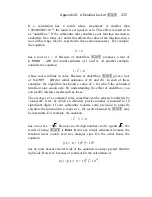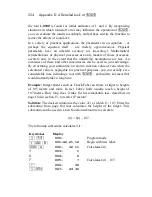
209
Appendix B
Stack Lift and
the LAST X Register
The HP-15C calculator has been designed to operate in a natural manner.
As you have seen working through this handbook, most calculations do not
require you to think about the operation of the automatic memory stack.
There are occasions, however – especially as you delve into programming –
when you need to know the effect of a particular operation upon the stack.
The following explanation should help you.
Digit Entry Termination
Most operations on the calculator, whether executed as instructions in a
program or pressed from the keyboard, terminate digit entry. This means
that the calculator knows that any digits you key in after any of these
operations are part of a new number.
The only operations that do
not
terminate digit entry are the digit entry keys
themselves:
0
through
9
“
−
.
‛
Stack Lift
There are three types of operations on the calculator based on how they
affect stack lift. These are stack-disabling operations, stack-enabling
operations, and neutral operations.
When the calculator is in Complex mode, each operation affects both the
real and imaginary stacks. The stack lift effects are the same. In addition,
the number keyed into the display (real X-register)
after any operation
except
−
or
`
is accompanied by the placement of a zero in the
imaginary X-register.
Summary of Contents for HP-15C
Page 1: ...HP 15C Owner s Handbook HP Part Number 00015 90001 Edition 2 4 Sep 2011 ...
Page 17: ...Part l HP 15C Fundamentals ...
Page 64: ......
Page 65: ...Part ll HP 15C Programming ...
Page 118: ...118 ...
















































